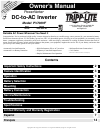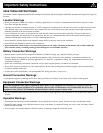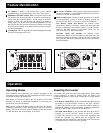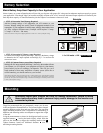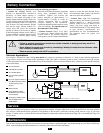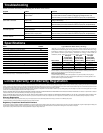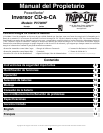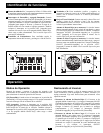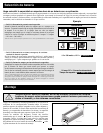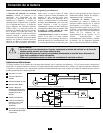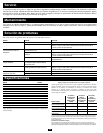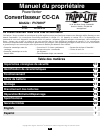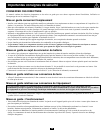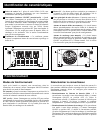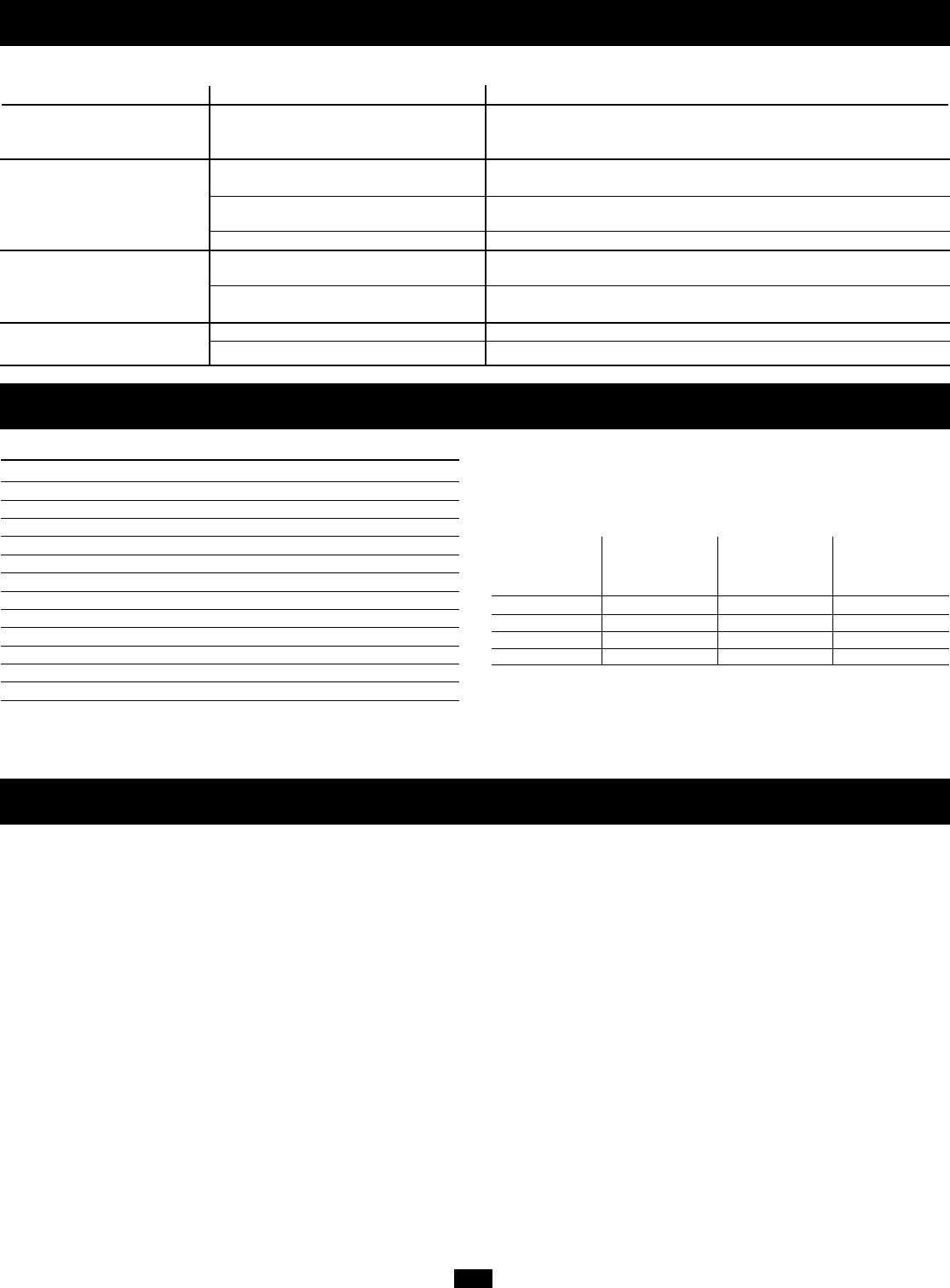
6
Please check the following before sending the Inverter in for service:
Troubleshooting
Model: PV700HF
Output Power (Maximum Continuous Watts)*: 700
Output Power (Peak Watts)**: 1400
Input Voltage (DC): 12V nominal (10-15V)
Output Voltage (AC)/Frequency: 120V / 60 Hz. nominal
Output Waveform: PWM Sine Wave
Low Battery Voltage Alarm (Volts): 10.5V
Low Battery Voltage Shutdown (Volts): 10V
AC Outlets: 3 (NEMA 5-15R)
Circuit Protection (Minimum DC Fuse Rating): 125-amp fuse (external)
Minimum Battery Cable Size: 6 AWG (4 mm)
Maximum Battery Cable Size: 4 AWG (5 mm)
Ground Cable Size: 12-18 AWG (1-2 mm)
Housing Material: Extruded Aluminum
* Maximum output power (continuous or peak) only available when vehicle battery is properly charged. Run vehicle engine
often to maintain proper charge. ** Peak Output Power is instantaneous.
Tripp Lite warrants its Inverters to be free from defects in materials and workmanship for a period of 1 year from the date of initial purchase. Tripp Lite’s obligation under this warranty is limited to repairing or replacing (at its sole option) any such defective
products. To obtain service under this warranty you must obtain a Returned Material Authorization (RMA) number from Tripp Lite or an authorized Tripp Lite service center. Products must be returned to Tripp Lite or an authorized Tripp Lite service center
with transportation charges prepaid and must be accompanied by a brief description of the problem encountered and proof of date and place of purchase.
This warranty does not apply to equipment which has been damaged by accident, negligence or misapplication or has been altered or modified in any way, including opening of the unit’s casing for any reason. This warranty applies only to the original
purchaser who must have properly registered the product within 10 days of purchase.
EXCEPTAS PROVIDED HEREIN, TRIPP LITE MAKES NO WARRANTIES, EXPRESS OR IMPLIED, INCLUDING WARRANTIES OF MERCHANTABILITY AND FITNESS FOR A PARTICULAR PURPOSE. Some states do not permit limitation or exclusion
of implied warranties; therefore, the aforesaid limitation(s) or exclusion(s) may not apply to the purchaser.
EXCEPT AS PROVIDED ABOVE, IN NO EVENT WILL TRIPP LITE BE LIABLE FOR DIRECT, INDIRECT, SPECIAL, INCIDENTAL OR CONSEQUENTIAL DAMAGES ARISING OUT OF THE USE OF THIS PRODUCT, EVEN IF ADVISED OF THE
POSSIBILITY OF SUCH DAMAGE. Specifically, Tripp Lite is not liable for any costs, such as lost profits or revenue, loss of equipment, loss of use of equipment, loss of software, loss of data, costs of substitutes, claims by third parties, or otherwise.
Warranty Registration
Visit www.tripplite.com/warranty today to register the warranty for your new Tripp Lite product. You'll be automatically entered into a drawing for a chance to win a FREE Tripp Lite product!*
* No purchase necessary. Void where prohibited. Some restrictions apply. See website for details.
Regulatory Compliance Identification Numbers
For the purpose of regulatory compliance certifications and identification, your Tripp Lite product has been assigned a unique series number. The series number can be found on the product nameplate label, along with all required approval markings and
information. When requesting compliance information for this product, always refer to the series number. The series number should not be confused with the marking name or model number of the product.
Tripp Lite follows a policy of continuous improvement. Product specifications are subject to change without notice.
Symptom Problem Correction
Alarm sounds. Low battery voltage (<10.5 V). Turn Inverter OFF and run engine to recharge vehicle battery.
Output overload. Turn Inverter OFF and remove overload by unplugging high-wattage devices. Load
should not exceed your Inverter's maximum continuous output power (see Specifications).
Inverter does not turn ON when Automatic Inverter shutdown due to low battery Turn Inverter OFF and run engine to
power switch is turned ON. voltage (<10V). recharge vehicle battery.
Automatic Inverter shutdown due to output overload. Turn Inverter OFF and remove overload by unplugging high-wattage devices. Load
should not exceed your Inverter’s maximum continuous output power (see Specifications).
Blown fuse. Replace fuse with standard automotive fuse of identical amperage (see Specifications).
Inverter is unable to power Battery running low. Low battery voltage reduces Turn Inverter OFF and run engine to recharge vehicle battery.
connected equipment. Inverter power output.
Connected equipment load exceeds Inverter’s Turn Inverter OFF and remove overload by unplugging high-wattage devices. Load
maximum continuous output power. should not exceed your Inverter's maximum continuous output power (see Specifications).
Connected equipment experiences Loose connections. Check and secure all connections.
audio/video distortion.
Audio/video interference. Reposition equipment antennas and Inverter.
Specifications
Limited Warranty and Warranty Registration
Typical Runtimes Before Battery Recharge
Although you can operate your Inverter with your vehicle engine off, best results are
usually attained with the engine running. Since the Inverter converts electrical energy
(and doesn’t produce it), the Inverter’s performance is relative to the condition of
your vehicle’s electrical system (battery, alternator and wiring). If other loads (air
conditioner, heater, lights, etc.) are also using power, you may get less runtime.
With Typical With Typical With Typical
Compact Vehicle Mid-Size Vehicle Full-Size Vehicle
(4 cylinder)
Battery,
(6 cylinder)
Battery,
(8 cylinder)
Battery,
Model: PV700HF Alternator & Wiring Alternator & Wiring Alternator & Wiring
1/2 Load (engine ON) continuous continuous continuous
Full Load* (engine ON) 1-2 hours 2-4 hours continuous
1/2 Load (engine OFF) not recommended 1 hours 2 hours
Full Load* (engine OFF) not recommended not recommended 1 hour
NOTE: You can maximize output power by following one or more of these steps: (1) connect multiple batteries to the
Inverter; (2) keep batteries fully charged by running the vehicle's engine often; (3) install the Inverter as close to the
batteries as possible; (4) connect the heaviest gauge cable possible to the Inverter's DC terminals; (5) use the Inverter in a
vehicle with a heavy-duty alternator; (6) run the vehicle's engine at higher RPMs.
Battery Wiring Recommendations
For maximum efficiency, keep battery wires as short as possible. For very short runs, 6 AWG (4 mm) wiring may be
adequate; for longer runs 4 AWG (5 mm) wiring is recommended. Acceptable output power is directly dependent on wire
length: the shorter the wiring, the better the performance.



